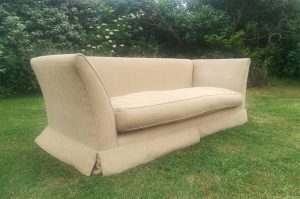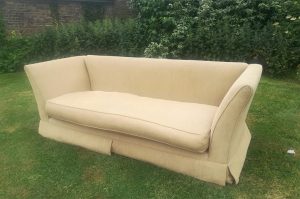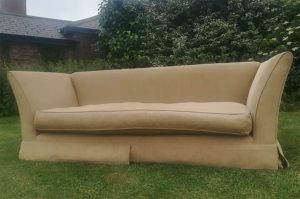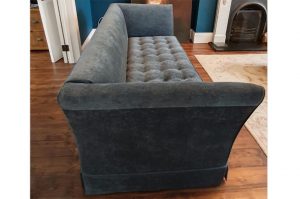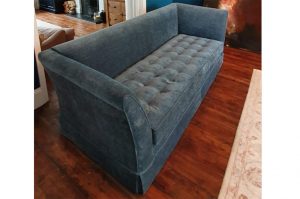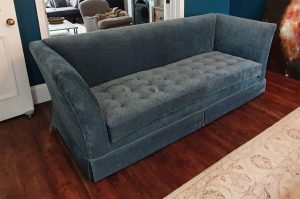Examining the Value of Reupholstery
For many, a sofa is more than just a piece of furniture; it’s the heart of the living room, a haven for relaxation, and a witness to countless memories. But time and wear can take their toll, leaving even the most beloved sofa looking faded, stained, or worse. Faced with a tired-looking sofa, the question arises: is it worth the value of sofa reupholstery, or is it time to invest in a new one?
The answer, like most things in life, isn’t a simple yes or no. Reupholstering offers a compelling blend of environmental and financial benefits, but it’s not without its drawbacks. To make an informed decision, it’s crucial to weigh the pros and cons carefully, considering factors like the quality of your sofa, the value of sofa reupholstery, and your personal attachment to the piece.
The Allure of Reupholstery: A Sustainable and Cost-Effective Choice
The value of sofa reupholstery shines as a sustainable alternative to discarding furniture. Landfills are overflowing with discarded furniture, and reupholstering breathes new life into an existing piece, reducing its environmental footprint. Additionally, reupholstery can be more cost-effective than buying a new sofa, particularly if the sofa’s frame is well-made and sturdy. High-quality hardwood frames, especially those with intricate joinery, can last for decades. Reupholstering allows you to capitalise on this strong foundation while refreshing the look and feel of your sofa.
Beyond environmental and financial benefits, reupholstery offers a surprising degree of customisation. Imagine transforming a dated floral pattern into a sleek and modern statement piece. You can choose from a vast array of fabrics, from luxurious velvets to durable leathers, to perfectly complement your existing décor. This level of personalisation allows you to create a unique piece that reflects your individual style.
Furthermore, reupholstery can address not just aesthetic concerns but also comfort issues. During the reupholstery process, you can have the cushions replaced with firmer or softer inserts, tailoring the sofa’s support to your specific needs. This can be a great option for a well-loved sofa that has lost some of its initial comfort but still boasts a strong frame.
Assessing Your Sofa: Is It a Candidate for Reupholstery?
Not all sofas are created equal, and some are better suited for reupholstery than others. Here are some key factors to consider when evaluating your sofa’s potential for a makeover:
- Frame Construction: The most crucial element is the quality of the frame. Look for frames made from solid hardwood like oak, maple, or walnut. These woods are strong and durable, providing a solid foundation for years to come. Avoid frames made from particleboard or softwoods, as they may not withstand the reupholstery process and future use.
- Spring System: Well-constructed sofas often utilise 8-way hand-tied springs. This traditional method provides superior support and longevity compared to cheaper serpentine or webbed spring systems. If your sofa has a well-made spring system, reupholstering allows you to retain this valuable feature.
- Extent of Damage: While reupholstery can address some structural issues, extensive frame damage or broken springs might make it more cost-effective to invest in a new sofa. However, minor repairs to the frame or spring system can often be done in conjunction with the reupholstery process.
Beyond the Basics: Additional Considerations
Once you’ve determined your sofa’s suitability for reupholstery, there are other factors to ponder:
- Cost of Reupholstery: Reupholstery costs can vary depending on the size and complexity of the sofa, the quality of the fabric you choose, and the upholsterer’s rates. Get quotes from several reputable upholsterers to get a realistic picture of the investment involved.
- Fabric Selection: The fabric you choose significantly impacts the look, feel, and cost of your reupholstered sofa. Consider factors like durability, stain resistance, and cleaning ease, especially if you have pets or children.
- Finding a Reputable Upholsterer: Skilled craftsmanship is essential for a successful reupholstery project. Look for upholsterers with experience working on similar pieces and positive customer reviews. Don’t hesitate to ask questions about their process, materials used, and warranty offered.
Reupholstery vs. Buying New: Weighing Your Options
While reupholstery offers significant benefits, there are situations where buying a new sofa might be a better choice. Here’s a breakdown to help you decide:
Reupholster When:
- You have a well-made sofa with a solid hardwood frame and a good spring system.
- You’re attached to the sofa for sentimental reasons or its unique design.
- You want the ability to completely customise the look and feel of your sofa with a wide variety of fabric options.
- You’re on a budget and the cost of reupholstery is significantly lower than buying a comparable new sofa.
- Sustainability is a priority for you, and you want to reduce your environmental impact.
Consider Buying New When:
- The frame of your sofa is weak, damaged, or made from low-quality materials like particleboard.
- The spring system is failing and requires extensive repairs.
- You desire a significant style change that wouldn’t be achievable through reupholstery alone.
- You need a new sofa urgently, as reupholstery projects can take weeks to complete.
- The cost of reupholstery with your desired fabric is close to or exceeds the price of a new sofa that meets your needs.
Ultimately, the decision to reupholster or buy new hinges on your specific circumstances, priorities, and budget. By carefully considering the factors outlined above, you can make an informed choice that aligns with your needs and values.
Bringing Your Sofa Back to Life: The Reupholstery Process
If you’ve decided to move forward with reupholstery, here’s a general overview of the process:
- Choosing an Upholsterer: Research and interview potential upholsterers. Ask for references, view their portfolio, and get a detailed quote outlining the work involved and the estimated cost.
- Fabric Selection: Work with the upholsterer to choose a fabric that suits your style, budget, and lifestyle needs. Consider factors like durability, stain resistance, and cleaning ease.
- Sofa Inspection: The upholsterer will thoroughly inspect your sofa to assess its condition and identify any necessary repairs to the frame or spring system.
- Disassembly and Stripping: The sofa will be carefully disassembled, and the old fabric and padding will be removed.
- Repairs and Rebuilding: Any necessary repairs to the frame or spring system will be undertaken at this stage.
- Padding and Reupholstery: New padding will be added for comfort, and the chosen fabric will be meticulously applied to the sofa frame.
- Finishing Touches: The reupholstered sofa will be reassembled and inspected for quality and craftsmanship.
The reupholstery process can take anywhere from a few weeks to several months, depending on the complexity of the project and the upholsterer’s workload. Be prepared to wait and enjoy a temporary seating arrangement while your beloved sofa undergoes its transformation.
The Joy of a Renewed Sofa: A Sustainable Investment
Reupholstering a sofa is more than just a cosmetic makeover; it’s an investment in your comfort, your home’s aesthetic, and the environment. By breathing new life into an existing piece, you not only save money and reduce waste but also create a unique and cherished item that reflects your personal style. So, the next time you look at your tired-looking sofa, consider the possibility of reupholstery. With careful planning and the right upholsterer, you can transform that faded piece into the heart of your living room for years to come.
For more information on the Value of Sofa Reupholstery contact Hill Upholstery.



